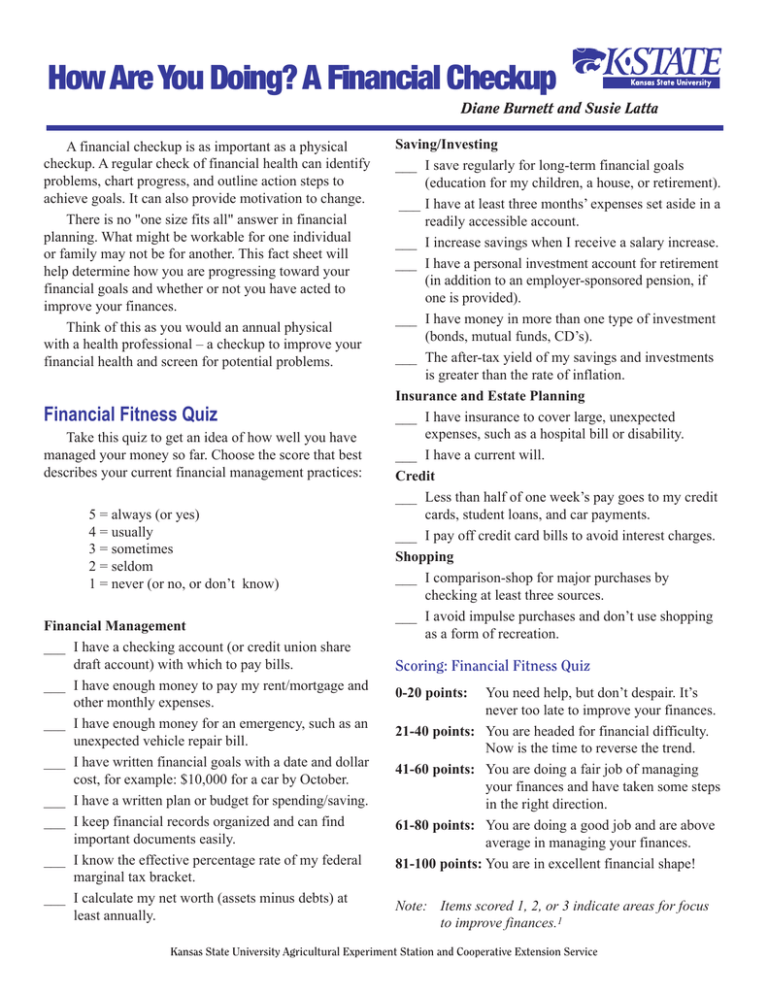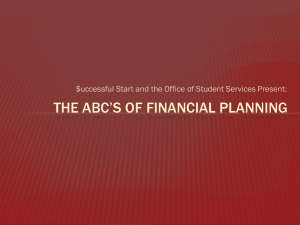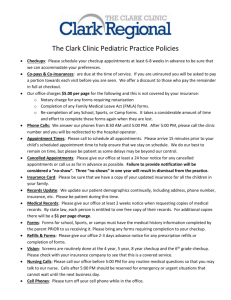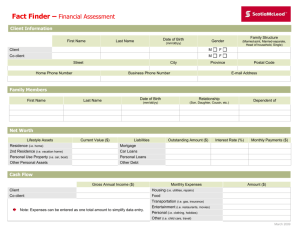
How Are You Doing? A Financial Checkup
Diane Burnett and Susie Latta
A financial checkup is as important as a physical
checkup. A regular check of financial health can identify
problems, chart progress, and outline action steps to
achieve goals. It can also provide motivation to change. There is no "one size fits all" answer in financial
planning. What might be workable for one individual
or family may not be for another. This fact sheet will
help determine how you are progressing toward your
financial goals and whether or not you have acted to
improve your finances.
Think of this as you would an annual physical
with a health professional – a checkup to improve your
financial health and screen for potential problems.
Financial Fitness Quiz
Take this quiz to get an idea of how well you have
managed your money so far. Choose the score that best
describes your current financial management practices:
5 = always (or yes)
4 = usually
3 = sometimes
2 = seldom
1 = never (or no, or don’t know)
Financial Management
___ I have a checking account (or credit union share
draft account) with which to pay bills.
___ I have enough money to pay my rent/mortgage and
other monthly expenses.
___ I have enough money for an emergency, such as an
unexpected vehicle repair bill.
___ I have written financial goals with a date and dollar
cost, for example: $10,000 for a car by October.
___ I have a written plan or budget for spending/saving.
___ I keep financial records organized and can find
important documents easily.
___ I know the effective percentage rate of my federal
marginal tax bracket.
___ I calculate my net worth (assets minus debts) at
least annually.
Saving/Investing
___ I save regularly for long-term financial goals
(education for my children, a house, or retirement).
___I have at least three months’ expenses set aside in a
readily accessible account.
___ I increase savings when I receive a salary increase.
___ I have a personal investment account for retirement
(in addition to an employer-sponsored pension, if
one is provided).
___ I have money in more than one type of investment
(bonds, mutual funds, CD’s).
___ The after-tax yield of my savings and investments
is greater than the rate of inflation.
Insurance and Estate Planning
___ I have insurance to cover large, unexpected
expenses, such as a hospital bill or disability.
___ I have a current will.
Credit
___ Less than half of one week’s pay goes to my credit
cards, student loans, and car payments.
___ I pay off credit card bills to avoid interest charges.
Shopping
___ I comparison-shop for major purchases by
checking at least three sources.
___ I avoid impulse purchases and don’t use shopping
as a form of recreation.
Scoring: Financial Fitness Quiz
0-20 points: You need help, but don’t despair. It’s never too late to improve your finances.
21-40 points: You are headed for financial difficulty. Now is the time to reverse the trend.
41-60 points: You are doing a fair job of managing your finances and have taken some steps in the right direction.
61-80 points: You are doing a good job and are above average in managing your finances.
81-100 points: You are in excellent financial shape!
Note: Items scored 1, 2, or 3 indicate areas for focus to improve finances.1
Kansas State University Agricultural Experiment Station and Cooperative Extension Service
Financial Goals
Income and Expense Statement
Financial goals should be SMART:
Specific (amount and time to achieve),
Measurable (show progress),
Attainable (be realistic), Relevant (be important for your needs), Time-related (deadline for attaining).
Consider time frames when making investment goal decisions. Short-term goals: less than a year
Intermediate goals: 1 to 5 years
Long-term goals: more than 5 years
Write down your goals to measure progress. Then,
for each goal, develop an action plan that includes the
amount needed and number of months available to
save. For each goal, divide number of months available
to save into that amount. Try to automate savings by
having part of each paycheck automatically deposited
into a designated account.
Most people probably haven't considered the idea
of spending $1,500 to $2,000 to have a comprehensive
individual or family financial plan written. While that
may seem like a lot of money, it may be worth the
investment. This publication will provide tools to assess
financial strengths and weaknesses, provide links to
electronic worksheets that can help with goal-setting,
and suggest ways to improve your financial health.
You can also check your financial health with an
income and expense statement. It will show how much
money you earn and spend. When calculating income,
be sure to include not just wages, but tax refunds,
interest earnings, child support, and any other seasonal
or nonwage income.
There are three categories of expenses: fixed (rent or
mortgage payment), variable (groceries, clothing), and
periodic or irregular (vacation, school expenses). The
difference between your income and expenses is your
cash flow, or the amount that is available for savings
and to reduce debt. (An income and expense statement
can be found in the K-State Research and Extension
publication “Basic Money Management,” S134G, on
page 10 of the printed "Budget Basics" section, or on
the Web at: http://www.oznet.ksu.edu/library/famec2/
S134G.pdf, on page 32 of the electronic version.)
Net Worth
An important step in gaining financial control is to
take an accounting of your total financial worth. Net
worth is calculated by subtracting debts from assets.
Assets include everything that you own. Debts (or
liabilities) include everything that you owe. Figure your
net worth annually to review your progress. Compare
each year’s figure with your financial goals. Ideally,
net worth should increase by 5 percent or more each
year as a result of increased savings and reduced debt.
In addition, a net-worth statement is a valuable aid in
planning your estate and establishing a record for loan
and insurance purposes. (See chart, next page.)
Financial Ratios
Financial ratios can be used as another kind of
checkup tool. Liquid assets should be equal to three
or more months of expenses always available for
emergencies. Total debt should be less than total assets,
or a household is technically insolvent. Annual debt
payments, including mortgage, should be 36 percent or
less of annual gross income.
• Liquidity Ratio: Liquid assets divided by monthly
expenses. (Should be equal to three months’
expenses or more.)
• Debt-to-Asset Ratio: Total liabilities divided by total
assets. (Should be less than 1.0, which indicates
insolvency.)
• Debt Payment to Income Ratio: Annual debt
payments divided by gross income. (Should be 0.36
or less.)
Net Worth Statement
Assets – What You Own
Liabilities – What You Owe
Cash: On hand
Checking Account
Savings Accounts
Money Markets
Other
Cash Value Life Insurance
$_______
$_______
$_______
$_______
$_______
$_______
Real Estate/Property:
Home
Land
Other
$_______
$_______
$_______
Investments: (Market value)
Certificates of Deposit
Stocks
Bonds
Mutual Funds
Annuities
IRAs
401(k) or 403(b) Plans
Pension Plans
Other
$_______
$_______
$_______
$_______
$_______
$_______
$_______
$_______
$_______
Loans Receivable
$_______
Personal Property (Current value)
Automobiles
$_______
Recreational Vehicle/Boat
$_______
Home Furnishings
$_______
Appliances / Furniture
$_______
Collections
$_______
Jewelry and Furs
$_______
Other
$_______
Total Assets $_______
Current Debts:
Household
Medical
Credit Cards
Department Store Cards
Back Taxes
Legal
Other
$_______
$_______
$_______
$_______
$_______
$_______
$_______
Mortgages:
Home
Land
Other
$_______
$_______
$_______
Loans:
Bank/Finance Company
$_______
Bank/Finance Company
$_______
Automobiles
$_______
Recreational Vehicle/Boat
$_______
Education
$_______
Life Insurance
$_______
Personal (from family / friends)$_______
Other
$_______
Total Liabilities
$_______
Subtract liability total from asset total to
figure net worth.
Total
Total
Net
-
=
Assets
Liabilities
Worth
Spending Plan/Budget
Credit Checkup
A spending plan includes projected amounts for
income and expenses. Ideally, income should equal
expenses plus money placed in savings.
Steps to make a spending plan:
• List anticipated sources of income
• List expenses – Fixed (include savings)
– Variable
– Periodic
• Compare budgeted amount with actual amount
• Adjust as necessary
A spending plan template can be found at: http://
www.oznet.ksu.edu/library/famec2/S134G.pdf. (See
page 34 of the electronic version or page 12 of the "Budgeting Basics" section.)
Your credit cards also need a checkup. Here are five
questions to get you started.
1. Do you have a credit card that you don’t use? If so,
cancel it with a written request to close the account,
noting that the account was closed by the account
holder.
2. Can you get a better interest rate? Call the credit
card company and ask for a lower rate.
3. Have you checked your credit report? Check
periodically for errors.
4. Do you keep a list of credit card contact information
(e.g., 800 numbers)?
5. Would refinancing/consolidation help?
Consumers are eligible to receive one free report
a year from each of the three major credit bureaus
(Equifax, TransUnion and Experian). They can be
ordered at http://www.annualcreditreport.com or by
calling 1-877-322-8228. To get a new report every four
months, rotate among the bureaus, using each annually.
To stop receiving credit card offers in the mail, tell
credit reporting agencies that you want to opt out of the
sale of your credit information. (Call 1-888-567-8688.)
Your credit score is a three-digit number that affects
how much you pay for credit, insurance and other
necessities. This number helps lenders identify the
level of risk their business assumes when lending or
providing insurance. To learn your credit score, you will
have to pay a fee, or it may be available from a lender
who recently denied you credit.
Tax Checkup
1. Pay necessary taxes but no more. Ideally you should
owe nothing and get no refund when your taxes
are figured. Why give the government a short-term
loan without interest? If you do get a large refund,
increase the number of deductions on your W-4
form to reduce the amount of money withheld from
your paycheck. Then you can use the money from
each paycheck to pay down debt or to increase
savings.
2. Itemize deductions when appropriate and keep
adequate records to justify those deductions.
3. Use tax credits (Earned Income Tax Credit or
Dependant Care Credit, for example) if eligible.
4. Know your marginal tax bracket. Use the
information to guide decisions about whether to
utilize taxable or tax-exempt investments. Check
your bracket each year for changes.
For updated tax bracket information, see:
http://www.dinkytown.net/java/TaxMargin.html, or
http://www.irs.gov/formspubs/article/0,,id=150856,00.
html.
Insurance Checkup
Umbrella Liability Policy
The purpose of insurance is to cover major
losses. Many people would not consider a television,
windshield, or microwave oven as a “major” loss,
so if you have savings, choose policies with higher
deductible amounts to reduce the premium. For more
information, see: www.iii.org.
• Umbrella liability insurance is so named because
it acts as an umbrella over your homeowner’s and
auto insurance policies to provide extra protection.
Purchase an umbrella policy if liability coverage on
auto and homeowner/renter policies is less than net
worth.
Homeowners Insurance
Disability Insurance
• Is your home insured for at least 80 percent of its
replacement cost?
• Do you have “replacement cost” riders on the
contents of your home?
If your home is not insured for at least 80 percent
of replacement value, insurance will not cover the
full cost of rebuilding after an insured loss. Financial
professionals often encourage purchase of “inflation
guard” coverage to keep home insurance from falling
below the 80 percent level. (The “guard” automatically
increases the coverage with the rate of inflation.) Make
sure insurance on your home and contents is for full
replacement coverage – not depreciated value.
It is important to have a written inventory of your
home’s contents. Store the inventory and supporting
photos or videos in a safe deposit box or another secure
location away from the home.
When a worker dies, his income stops, but so does
consumption of goods and services. When a person
becomes disabled and can’t work, income stops but
expenses continue. From that standpoint, disability
insurance is just as important – maybe even more
important – than life insurance.
Disability insurance should replace 60 to 70 percent
of monthly income until the worker is eligible for
retirement. There are two types of coverage: “own
occupation” versus “any occupation.” It is important to
understand the way your policy defines a disability and
covers your ability to work.
If an employee pays for disability coverage,
distributions are received tax-free. If your employer
pays for disability coverage, distributions are taxable
to the recipient because it is considered an employee
benefit.
Auto Insurance
Life Insurance
• Do you have at least $300,000 of auto liability
insurance?
• Required Kansas minimum auto insurance is
$25,000/$50,000/$10,000; recommended is $100,000/$300,000/$50,000.
What do those figures mean? The minimum liability
limit is $25,000 for bodily injury for one person injured
in an accident, but $100,000 is recommended. In Kansas
the minimum liability requirement is $50,000 for all
injuries in one accident, but $300,000 is recommended.
The minimum liability requirement for property damage
in an accident is $10,000, but $50,000 is recommended.
Financial planners generally estimate most workers
need 75 percent of current household income in the
event of the wage earner’s death. Take that number
times the number of years that income is needed, add
additional expenses (such as repayment of debts) and
subtract existing assets and a survivor’s income, if
any. The total equals the approximate amount of life
insurance coverage needed. Life insurance should be
reviewed as family needs change through life stages.
Life insurance calculators are available on the web
to help figure individual need. An example of a life
insurance calculator can be found at http://www.life-line.
org. Or use the formula below :
Current and
future financial
obligations
Existing
resources
-
(survivor's
=
Life insurance
need
earnings, etc.)
Health Insurance
Does your health insurance have high coverage
limits and few exclusions? Stay current on insurance
premiums, and save an emergency reserve to meet
deductible, co-insurance amounts and uninsured
medical costs. Build your knowledge of risk, costs, and
financing options for health care, and develop a plan
for managing long-term health-care needs. Consider
new medical savings plans that may be available for use
with high-deductible health insurance policies. Consider
participating in your company’s cafeteria plan.
Long Term Care Insurance (LTC)
If you are generally in good health and have assets
that you’d like to protect and pass on to your heirs,
consider long term care insurance. Information on LTC
policies can be requested from the office of the Kansas
Insurance Commissioner at 1-800-432-2484 or online
at: www.ksinsurance.org.
Social Security and Pension Checkup
As you consider the state of your retirement plans,
be sure to check on your expected Social Security and/
or pension benefit. Also be alert to pension plan changes
– a switch from a traditional defined benefit plan to a
cash balance (defined contribution) plan, for example
– and determine which is in your best interest.
Review your annual Social Security benefit report.
This is usually received in the mail a few months before
your birthday.
• Review retirement benefits at age 62 versus full
retirement age, depending on date of birth.
• Note disability benefit amount.
• Check accuracy of annual earning amounts.
• Request a defined benefit pension estimate or check
the balance of your defined contribution plan.
Retirement Checkup
Assessing progress toward retirement goals is also
important. First, estimate the amount of income you’ll
need annually. Then:
• Subtract Social Security, pension (if any), earnings
from work or investments, etc.
• Estimate retirement age and life expectancy.
• Determine total required to cover the estimated
number of retirement years.
• Add up the value of existing retirement savings
accounts (IRA, 401(k), etc.)
• Subtract future value of savings (See www.
arkansasrunner.com/calculators/futureval.htm)
• Calculate total savings needed and annual (or perpaycheck) savings amount.
When saving for retirement, try to contribute the
maximum, but at least contribute the amount required
to receive an employer match, if available. Understand
your employer-sponsored retirement plan. You need
to know about vesting rules (if they apply), when you
can retire, and what employer-sponsored benefits will
remain after retirement. Understand withdrawal options
for your retirement benefits: life, life annuity, joint and
survivor, lump-sum payment, or installment options.
In addition to your employer-sponsored retirement
plan, contribute to an individual retirement account
(IRA). Make sure you compare different plans:
traditional IRAs versus Roth. Required minimum
distribution begins at age 70 1/2 for traditional IRAs,
401(k) plans, and other pension programs.
It is important to contribute to a personal savings/
investments plan as well. Such a fund may already have
been established for other goals, such as children’s
education, a second home, or other dreams.
Retirement Checkup Tools
• Ballpark Estimate worksheet (available online at
www.asec.org)
• www.ces.purdue.edu/retirement
(10 modules with online calculators)
Investment Checkup
Risk Tolerance
A risk tolerance checkup is in order to make sure
investments match your tolerance for risk. Complete the
Understanding Your Risk Tolerance Quiz at: http://www.
rce.rutgers.edu/money/riskquiz to determine your level
of risk-tolerance. The score will indicate appropriate
investment tools. Remember that younger workers can
usually bear more risk.
Asset Allocation
After-Class Evaluation Form: Financial Checkup
Be sure to do a regular asset allocation checkup.
Increase your earnings by matching your personal risktolerance level with appropriate savings/investment
services and products to achieve an acceptable rate of
return. Choose an appropriate asset allocation model to
balance growth and income for your age. One guide is
that you should not have a higher percentage of money
invested in the stock market than 100 minus your age.
If percentages of your portfolio in stocks, bonds, or
cash have strayed from original weightings, rebalance
to get back on track. Choose appropriate savings/
investments to match investment goals. Evaluate your
plan regularly to make sure savings and investments are
appropriately balanced to achieve maximum earnings
consistent with risk-tolerance level and goals.
Date: _______________________
Investment Performance
Review investments to see if they are providing
the rate of return you expect. You can do this for each
investment or for the total portfolio. A financial advisor
or investment professional will be able to help you
calculate the current rate of return.
To do the calculation yourself, you need to know
your beginning and ending account balance and the
amount of money deposited in the account throughout
the year. These are the steps:
• Write down beginning balance and ending balance.
• Add half of annual contributions to the beginning
balance and subtract half of annual contributions
from the ending balance.
• Divide the adjusted ending balance by the adjusted
beginning balance; convert total into a percentage.
Estate Planning Checkup
Develop an integrated plan for accumulating,
protecting, and distributing/transferring assets.
Major Considerations
Do you have a letter of last instruction and will?
Prepare a letter of last instruction including:
• Location of personal documents, financial papers
and accounts.
• Names, addresses and phone numbers of family and
close friends. (continued on back)
Please circle the value of this class to you:
Extremely
valuable
Very
Valuable
valuable Somewhat
valuable
No
value
As a result of this class, how much knowledge did
you gain?
A lot
Some
Little
None
Comments or suggestions about the program:
______________________________________
______________________________________
______________________________________
______________________________________
As a result of this class, what action(s) do you plan to
take in the future? (Check all that apply)
_____ Set one or more specific written financial goals
_____ Calculate net worth (assets minus debts)
_____ Start or increase emergency savings fund
_____ Organize financial records
_____ Prepare a spending plan (budget)
_____ Check a copy of personal credit report
_____ Determine marginal tax bracket
_____ Establish a personal retirement savings account
_____ Review investment asset allocation and diversify holdings
_____ Purchase adequate insurance, especially for large potential losses
_____ Draft/update a will
_____ Other (please explain)____________________
______________________________________
______________________________________
______________________________________
______________________________________
Send a copy of completed evaluation form to:
Carol Young, Extension Specialist, Family Financial
Management, Kansas State University, 343 Justin
Hall, Manhattan, KS 66506.
For more information, contact the authors:
Diane Burnett, M.S.
Family and Consumer Sciences Agent
Miami County, 20 S. Gold
Paola, KS 66071-2200
Considerations for your will
Susie Latta, M.S.
Family and Consumer Sciences Agent
Marshall County
1201 Broadway
Courthouse
Marysville, KS 66508-1844
1Financial
Fitness Quiz (page 1) was created by Barbara
O’Neil, Specialist in Financial Resource Management, Rutgers
Cooperative Research and Extension, New Jersey.
Brand names appearing in this publication are for
product identification purposes only. No endorsement is
intended, nor is criticism implied of similar products not
mentioned. Publications from Kansas State University
are available on the World Wide Web at:
www.oznet.ksu.edu.
Publications from Kansas State University may be freely
reproduced for educational purposes. All other rights
reserved. In either case, credit Diane Burnett and Susie
Latta, "How Are You Doing? A Financial Checkup,"
Kansas State University, August 2006.
Kansas State University Agricultural Experiment Station and
Cooperative Extension Service, Manhattan, Kansas
MF-2721
AUGUST 2006
K-State Research and Extension is an equal opportunity provider and employer. These
materials may be available in alternative formats. Issued in furtherance of Cooperative
Extension Work, Acts of May 8 and June 30, 1914, as amended. Kansas State University,
County Extension Councils, Extension Districts, and United States Department of Agriculture
Cooperating, Fred A. Cholick, Director.
(continued from previous page)
• Personal and financial professionals who need to be
notified of your death.
• Names of people you wish to receive special things.
• Preferences for services and disposition of the body,
as well as any information about prepaid funeral
plans or location of cemetery plot you may own.
• Have you looked at your will in the last five years or
after a major life event, such as death or divorce?
• Name personal and/or financial guardian for
dependents, if appropriate.
• Choose executor and trustee for your estate plan.
• Prepare information about financial records so an
executor can take over immediately.
• Have you recently reviewed beneficiary
designations on insurance and retirement accounts?
• Are there conflicts between your will and the titling
of assets? Use appropriate form of ownership: It
influences the way your estate is valued and how
property is transferred. (For example, payable on
death? Or joint tenancy with rights of survivorship?)
• Do you have a living will or medical power of
attorney? (Living will expresses your wishes
concerning life-sustaining procedures in case of
terminal illness and/or imminent death. Durable
power of attorney for medical decisions grants
power to a person you choose to make health-care
decisions if you are unable to do so.)
• Who will handle finances if you are unable to do
so? A durable power of attorney for finances grants
powers to the person of your choice if you are
physically or mentally unable to do so.
• Decide who will get what and when. Who do you
want to receive your assets? How much do you want
each heir to receive? When do you want them to
receive the assets? How should the asset be given?
Final Thoughts
Like a physical, a financial checkup can help
identify problems – such as a high debt load – and
evaluate progress toward goals. It can also identify
future action steps and provide motivation to form new
habits and improve your financial health.



